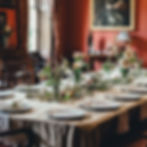The Art of Setting the Perfect Dinner Table
- jamie2062
- May 15, 2024
- 3 min read

Setting the table for dinner is more than just placing utensils and glassware on a surface; it's an art form that reflects hospitality, tradition, and attention to detail. Whether you're hosting a formal dinner party or a casual gathering with friends, knowing the proper way to set the table can elevate the dining experience for both you and your guests. Let's delve into the intricacies of setting the perfect dinner table, from the placement of cutlery to the history behind this age-old tradition.
1. The Foundation: The Tablecloth or Placemat
Before anything else, lay down a clean tablecloth or placemats. This foundation not only protects your table but also sets the stage for an elegant dining experience. Choose a tablecloth that complements your dinnerware and enhances the overall aesthetic of your table setting.
2. The Essentials: Plates, Bowls, and Napkins
Start by placing the dinner plate in the center of each setting, followed by any additional plates or bowls that will be used throughout the meal, such as salad plates or soup bowls. Position the napkin to the left of the plate, either folded neatly or placed in a decorative napkin ring.
3. The Main Attraction: Cutlery Placement
Proper placement of cutlery is key to setting a formal table. Place the forks to the left of the plate, with the salad fork on the outside and the dinner fork closest to the plate. On the right side of the plate, place the knife closest to the plate with the blade facing inward, followed by the soup spoon (if needed), and then the dessert spoon or fork. If serving seafood, include a seafood fork to the right of the other forks.
4. Glassware: Cheers to Elegance
Position the water glass directly above the knife, with the wine glasses placed to the right and slightly above the water glass. If serving multiple types of wine, arrange the glasses in the order they will be used, from left to right. For example, white wine glasses should be placed to the right of the water glass, followed by red wine glasses.
5. Finishing Touches: Decor and Ambiance
Enhance the ambiance of your table setting with thoughtful decor elements such as floral centrepieces, candles, or decorative placeholders. These finishing touches add warmth and charm to your table while making guests feel welcome and appreciated.
History and Interesting Facts:
- The tradition of setting the table dates back centuries and varies across cultures. In medieval times, elaborate feasts were often served on long, communal tables with an assortment of dishes and utensils.
- The concept of individual place settings became more common during the Renaissance period, as dining etiquette evolved to reflect social status and refinement.
- In formal dining settings, the placement of cutlery and glassware follows a standardised protocol to ensure consistency and elegance.
- The practice of using specific utensils for different courses originated in Europe and was influenced by French dining customs, which emphasised precision and sophistication.
- Today, while formal table settings are still prevalent for special occasions and formal events, many people opt for more casual and eclectic table arrangements that reflect their personal style and preferences.
In conclusion, setting the perfect dinner table is an art that combines tradition, elegance, and hospitality. By paying attention to detail and following the guidelines outlined above, you can create a dining experience that is both memorable and enjoyable for you and your guests. So, the next time you gather around the table, take a moment to appreciate the beauty and significance of a well-set table. Cheers to good company and great food!
